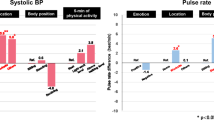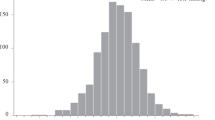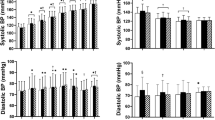Abstract
Blood pressure is affected by situational anxiety, such as the white coat effect. We hypothesised that blood pressure would also be affected by anticipation of a blood test. Volunteer subjects were recruited on the campus of Birmingham University. Subjects were randomly assigned to intervention and control groups. After a period of rest, three seated blood pressure measurements were taken at 1-min intervals using an electronic sphygmomanometer. Between the second and third measurements subjects in the intervention group were told that a blood test would be carried out after the last measurement. No blood test was carried out. Three blood pressure measurements were made in all 213 randomised subjects. Analysis was by intention-to-treat. In the control group mean systolic and diastolic blood pressure fell in successive measurements. Between the second and third measurements mean systolic blood pressure fell by 1.4 mm Hg in the control group and rose by 2.6 mm Hg in the intervention group (difference 4.0 mm Hg, P < 0.0001). A rise in diastolic blood pressure between the second and third measurements did not reach statistical significance. It was concluded that anticipation of a blood test affects measured systolic blood pressure in volunteers. The practice of taking blood tests at the same time as measuring blood pressure may potentially bias estimations of blood pressure.
This is a preview of subscription content, access via your institution
Access options
Subscribe to this journal
Receive 12 digital issues and online access to articles
$119.00 per year
only $9.92 per issue
Buy this article
- Purchase on Springer Link
- Instant access to full article PDF
Prices may be subject to local taxes which are calculated during checkout



Similar content being viewed by others
References
British Hypertensive Society. Guidelines for management of hypertension J Hum Hypertens 1999 13: 569–592
Reeves RA . Does this patient have hypertension? How to measure blood pressure J Am Med Assoc 1995 273: 1211–1218
Pickering TG et al. Blood pressure monitoring. Task force V: white-coat hypertension Blood Press Monit 1999 4: 333–341
Saab PG et al. Cardiovascular responsivity to stress in adolescents with and without persistently elevated blood pressure J Hypertens 2001 19: 21–27
Carroll D et al. Blood pressure reactions to acute psychological stress and future blood pressure status: a 10-year follow-up of men in the Whitehall II study Psychosom Med 2001 63: 737–743
Strandberg TE, Salomaa V . White coat effect, blood pressure and mortality in men: prospective cohort study Eur Heart J 2000 21: 1714–1718
Verdecchia P . White-coat hypertension in adults and children Blood Press Monit 1999 4: 175–179
Lantelme P, Milon H, Vernet M, Gayet C . Difference between office and ambulatory blood pressure or real white coat effect: does it matter in terms of prognosis? J Hypertens 2000 18: 383–389
Light KC et al. High stress responsivity predicts later blood pressure only in combination with positivefamily history and high life stress Hypertension 1999 33: 1458–1464
Khattar RS, Senior R, Lahiri A . Cardiovascular outcome in white-coat versus sustained mild hypertension: a 10-year follow-up study Circulation 1998 98: 1892–1897
Quas JA, Hong M, Alkon A, Boyce WT . Dissociations between psychobiologic reactivity and emotional expression in children Development Psychobiol 2000 37: 153–175
Crippa G et al. Psychological constructs associated with emotional blood pressure response and white coat phenomenon Annali Italiani di Medicina Interna 2000 15: 250–254
Wood D et al on behalf of the Societies. Joint British recommendations on prevention of coronary heart disease in clinical practice Heart 1998 80 (Suppl 2): S1–S29
Bakx JC et al. De invloed van een rustperiode op de bloeddruk. (The influence of a rest period on blood pressure measurement ) Huisarts en Wetenschap 1999 42: 53–56
Chrysant SG . Treatment of white coat hypertension Curr Hypertens Rep 2000 2: 412–417
Carroll D et al. Cardiovascular reactions to psychological stress: the influence of demographic variables J Epidemiol Commun Health 2000 54: 876–877
Uchino BN, Uno D, Holt-Lunstad J, Flinders JB . Age-related differences in cardiovascular reactivity during acute psychological stress in men and women J Gerontol Series B-Psycholog Sci Social Sci 1999 54: P339–P346
Acknowledgements
Thanks are due to Michelle Beevers for training the researchers.
Author information
Authors and Affiliations
Corresponding author
Rights and permissions
About this article
Cite this article
Marshall, T., Anantharachagan, A., Choudhary, K. et al. A randomised controlled trial of the effect of anticipation of a blood test on blood pressure. J Hum Hypertens 16, 621–625 (2002). https://doi.org/10.1038/sj.jhh.1001460
Received:
Revised:
Accepted:
Published:
Issue Date:
DOI: https://doi.org/10.1038/sj.jhh.1001460
Keywords
This article is cited by
-
Variation in recorded blood pressure terminal digit bias in general practice
Journal of Human Hypertension (2008)
-
Blood pressure measurement: the problem and its solution
Journal of Human Hypertension (2004)



